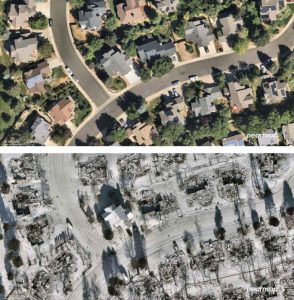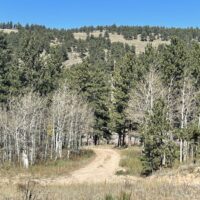2022 and Beyond: Market Analysis and Marshall Fire
By Karen Libin, John Dabbs, and Lou Barnes
Photo Credit: Wildfire Today
We are long-time Colorado real estate and mortgage people, cumulative experience among the three of us 94 years, and we write to you with the long view.
Some years, even whole decades (as 2010-2019) are reasonably predictable. However, any short-term outlook today will be confounded by wild cards: Covid, inflation, the Fed, election, Ukraine, and a surprise or two.
So, stick with forces which are likely to continue: land use, IT employment, and the Marshall Fire.
In 2020, Covid exposed our greatest benefit and risk: we have run out of residential land. Covid pushed workers home and launched home mini-schools. Many thousands of people felt short of square footage, auction conditions resulted, focused on single family homes, the auction propelled by the Metro area’s intense IT success. In 2021 the rate of appreciation of Boulder single family homes was four times that of attached, and a lesser but strong multiple in all County towns.
It is one thing to run short of housing and need time to build, and another to reach an end to supply. From Ft. Collins to Castle Rock, only a few infill patches remaining west of I-25, we are in sight of The End, the creation of the last lot for a single-family home. A signal in prices: until this Covid surge, homes were cheaper per square foot as buyers looked east toward I-25 — no longer, Broomfield, Lafayette, Arvada, and Westminster converging. This terminal stage has collided with IT growth and high incomes. IT is moving so fast and with such success that we no longer have a good definition — just think, how many people whom you know do their jobs on screens?
We can rezone from commercial to residential, and will, and can densify and go vertical, but rezoning is a political pain, takes time, and market acceptance for living compactly will take time. The multiple offers over ask for single-family homes will fizzle at some point temporarily, but in Boulder County we will wrestle in the net of fixed supply versus growing demand and incomes… for good.
We can meliorate the price/supply rigidity with better transportation. However, RTD has been slow and expensive, and no transit system pays for itself. When and how the Front Range will collaborate and tax itself is over the horizon, but we can.
The Marshall Fire. We do not mean to minimize in any way the loss of treasures and peace of mind, nor the pandemic of under-insurance. But strictly as an economic matter, and weirdly because of the land use issues above, most households will come through this financially intact, even ahead. The reason: the extremely high values of land under the homes which burned. The older the home, the more the depreciation of the physical sticks; insurance will underpay, forcing many to larger mortgages, but the result will be brand-new homes on very valuable lots and much higher overall value.
The neighborhoods today looking like Dusseldorf in 1945… thanks to the County and two towns and FEMA, every burned lot is scheduled to be builder-ready by July. Ambrose Bierce wrote this syllogism: “If one man can dig a post hole in sixty seconds, then surely sixty men can dig the hole in one second.”
We’ll need builders and materials, but soon Louisville and Superior will benefit from a new miracle of loaves and ashes, a very strange infernal urban renewal.





